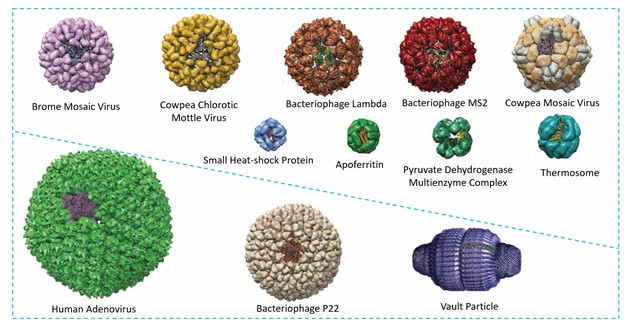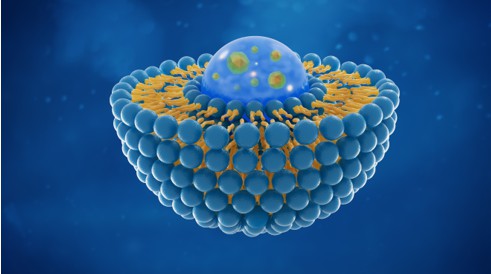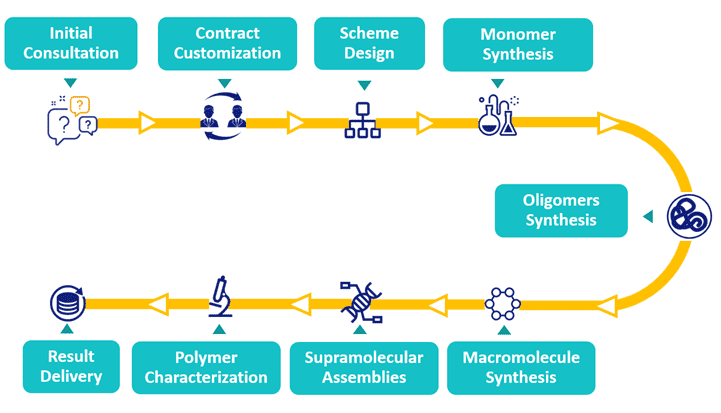Protein Cage-based Polymer Conjugation Technologies
Modification of protein cages with polymers can reduce their immunogenicity and antigenicity, increase the protein particles' circulation time in vivo, stabilize and protect protein cages against degradation by proteases and other degrading enzymes, and decrease protein-protein interactions. Moreover, polymers can be used as flexible spacers to bind targeting molecules to the proteins to enhance the interaction of these targeting ligands with receptors on the surface of cells. As polymers can be designed to feature multiple copies of functional groups along their structure, they can be used to bind a high number of contrast agents or drug molecules on the protein cages.
BOC Sciences provides the most complete protein-polymer conjugate solutions for the pharmaceutical and materials industries. Our chemistry team can help you design synthetic routes, select the best conjugation location, and synthesize and prepare various protein-polymer compounds. The protein cages we use in conjugation with polymers include non-viral protein cages and virus-derived icosahedral protein cages, which has been explored as functional nanoparticles for applications in nanotechnology, drug delivery and functional materials.
Introduction of Protein Cage-based Polymer Conjugates
Protein cages are hollow protein nanoparticles, such as viral capsids, virus-like particles, ferritin, heat-shock proteins and chaperonins. Protein cages are ideal building blocks for bionanotechnology because of their well-defined size and capsule-like structures. Moreover, they are non-toxic, biodegradable and many exhibit chemical and thermal stability. Their protein subunits can be modified by genetic engineering at predetermined positions, allowing for example site-selective introduction of attachment points for functional groups, catalysts or targeting ligands on their outer surface, in their interior and between subunits. Therefore, protein cages have been extensively explored as functional entities in bionanotechnology, as drug-delivery or gene-delivery vehicles, as nanoreactors or as templates for the synthesis of organic and inorganic nanomaterials.
 Fig. 1. Structures of protein cages (Chem. Mater. 2018, 30(17): 609-6098).
Fig. 1. Structures of protein cages (Chem. Mater. 2018, 30(17): 609-6098).
The scope of functionalities and applications of protein cages can be significantly broadened if they are combined with synthetic polymers on their surface or within their interior. For instance, PEGylation of protein cages is a very popular and effective strategy to reduce the immunogenic response facilitating their usage for biomedicine. Surface engineering with functional polymers offers stimuli-responsiveness, increased stability, and solubility in organic solvents. Polymers within protein cages offer the possibility of increasing the loading density of drug molecules, nucleic acids, magnetic resonance imaging contrast agents or catalysts. Moreover, the interaction of protein cages and polymers can be used to modulate the size and shape of some viral capsids to generate structures that do not occur with native viruses. Another possibility is to use the interior of polymer cages as a confined reaction space for polymerization reactions such as atom transfer radical polymerization (ATRP) or rhodium-catalysed polymerization of phenylacetylene.
Applications of Protein Cage-based Polymer Conjugates
Drug Delivery
Most polymeric materials, when brought into contact with solution of proteins, will adsorb some of the biomacromole-cules at their surface. For example, dendritic PAMAM has been conjugated into the protein cage thermosome, a group ll chaperonin that possesses a large pore size of 7 nm. The thermosome-PAMAM conjugate was successfully used for small interfering ribonucleic acid (siRNA) delivery and templated synthesis of gold nanoparticles inside of the protein cage.
Bionanomaterials

Protein cages have a monodisperse structure. In combination with synthetic polymers they can be self-assembled into well-defined bio-hybrid materials that are characterized by a regular 2-D or 3-D array of protein nanoparticles. Such regular and large arrangements of soft nanomaterials are of particular interest for biomedical and materials research, because they can be used to create 2- and 3-dimensional materials with defined, periodic architectures with long-range order. Moreover, the protein cages can be used for encapsulation and release of active substances within these hybrid materials.
Materials Sciences
Protein cages are robust biological nanoparticles that have a variety of properties that are difficult or impossible to achieve with synthetic nanocapsules. Therefore, protein cages were incorporated into synthetic polymeric materials with the aim to create functional hybrid materials. For example, self-reporting (or self-sensing) materials can autonomously report micron-scale damage and have therefore high potentials safety features in load-bearing components in the aerospace, automotive, construction and medical materials sectors.
Our Protein Cage-Polymer Bioconjugation Services
External Surface Bioconjugation of Protein Cages
Protein cages can be easily modified with polymers on their outside, as their surface is freely accessible for reagents from solution. Currently, conjugates of protein cages and polymers have been synthesized by many of the well-known methods to prepare protein-polymer coniugates, such as the binding of preformed polymer chains to proteins via chemical linkers (grafting-to), the growing of polymer chains from protein-bound initiators (grafting-from), and the non-covalent bindling of polymers to proteins, e.g. through multiple electrostatic interactions. As a leading supplier of monomers and polymers bioconjugation, BOC Sciences specializes in the production of protein-polymer conjugates via ATRP and reversible addition-fragmentation chain transfer (RAFT) polymerization to meet your research and production needs. Our reagents and technology are optimized to achieve timely delivery of polymer products with superior quality.
Internal Surface Bioconjugation of Protein Cages
In addition to the functionalization of the outer surface, polymers can be conjugated to the internal surface of polymer cages using reactive groups such as maleimides, activated carboxylic acids or via click chemistry. With advanced instruments and experienced R&D teams, BOC Sciences provides protein cages with well-defined templates for grafting synthetic polymers with defined inner holes and outer surfaces to facilitate customer research in drug delivery and bioimaging. In addition, we also provide the most comprehensive assistance in the self-assembly of protein-polymer conjugates into protein cages and protein cage-mimicking nanostructures. The protein cages we use in conjunction with polymers include:

Our Polymer Bioconjugation Workflow

Referenced
- Weil, T. et al. Polymer bioconjugates: modern design concepts toward precision hybrid materials. Progress in Polymer Science. 2020, 105: 101241.
- Bruns, N. et al. Protein cages and synthetic polymers: a fruitful symbiosis for drug delivery applications, bionanotechnology and materials science. Chem. Soc. Rev. 2016, 45(22): 6213-6249.

 Fig. 1. Structures of protein cages (Chem. Mater. 2018, 30(17): 609-6098).
Fig. 1. Structures of protein cages (Chem. Mater. 2018, 30(17): 609-6098).








